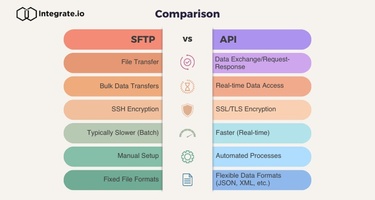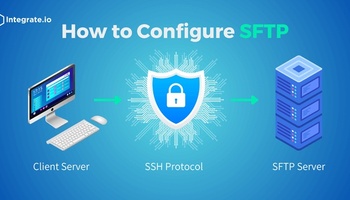Data integration methods are critical for maintaining operational efficiency and a competitive edge as the digital world evolves. Two popular methods—Secure File Transfer Protocol (SFTP) and Application Programming Interfaces (APIs)—offer unique benefits depending on your needs.
While SFTP is like a secure courier, encrypting and delivering data packages precisely where they're meant to land, APIs act as a communication channel, allowing different software systems to interact and exchange data in real time.
Understanding the differences between these two can help you choose the best method for your data integration needs. In this guide, we'll discuss SFTP vs. API so you have a clear understanding of how they work and their benefits.
Here are the five key takeaways to consider:
- Secure file transfer protocol (SFTP) is a method of transferring data using flat files.
- An application programming interface (API) allows apps or services to interact with one another.
- The key differences between SFTP and APIs involve the data transfer methods, use cases, and how many resources are consumed.
- For bulk data transfers, SFTP might be the better choice for your business.
- For real-time data flow, an API might be the best option. The right choice does depend on your unique business needs.
What Is SFTP?
SFTP, or Secure File Transfer Protocol, is a secure method of transferring data over networks using flat files. It leverages the power of SSH (Secure Shell) protocol to ensure data in transit remains private and intact.
While often mistaken for its predecessor, FTP (File Transfer Protocol), SFTP is a step ahead regarding security. Unlike FTP, which transmits data in plain text, SFTP encrypts data before sending, ensuring safety even in the event of interception. It's an ideal choice for bulk file transfers.
How Does SFTP Work?
The process of SFTP follows a few stages:
- SSH establishes a secure connection between the client (the sender) and the server (the recipient). This secure connection guarantees that the data transferred can't be intercepted mid-transit.
- Once the secure connection is confirmed, the data transfer begins. The data is encrypted before being sent, then decrypted upon receipt. This process happens in real time, ensuring the safety of the data.
- The final step is verification. The recipient server returns an acknowledgment to the sender, confirming the successful and unaltered receipt of the data.
Benefits of SFTP
SFTP has several significant benefits, making it a preferred choice for data transfers among many businesses:
- Robust security: SFTP protects data with strong encryption measures during transit.
- Data integrity: SFTP includes in-built mechanisms to promptly identify and manage any alterations during the transfer.
- Control: This method enables precise file transfer management, including resuming interrupted transfers.
- Automation: SFTP facilitates time-saving and error-minimizing automation with the right tools.
What Is an API?
An API, or Application Programming Interface, is a communication intermediary that allows two software applications to talk and interact. Think of an API as a menu in a restaurant—you specify what you want (place an order), and the kitchen (the system) uses that order to give you what you asked for.
APIs lay out the groundwork for how software components should interact. They define the methods and data formats a program (the client) can use to communicate with another program (the server) or a different part of the same program. An API is not a database or server—it's the code governing the server's access points.
How Does an API Work?
APIs work through a process of requests and responses. Let's continue with our restaurant analogy. When you place an order (make a request), the kitchen (the server) prepares your dish and sends it back to you (the response).
A client sends a request to the API with specific instructions about what it wants. This request is made in a file format defined by the API—much like ordering food from a menu.
The API receives the request, understands it, communicates with the relevant system or database, and retrieves the requested information. The API then sends this information back to the client in response.
Benefits of an API
- Efficiency: APIs allow different software systems to communicate directly, saving time and resources and increasing workflow efficiency.
- Integration: APIs enable the integration of different systems and services, helping businesses streamline their operations and provide seamless customer experiences.
- Automation: With APIs, tasks that would otherwise require manual effort can be automated, further enhancing productivity.
- Customization: APIs allow developers to customize the functionality of an existing product, creating a more tailored solution that fits specific business needs.
SFTP vs. API: Key Similarities
Here are the key similarities between SFTP and APIs:
- Data transfer: Both SFTP and APIs facilitate data transfer between systems.
- Security: Both methods place a high emphasis on maintaining data security during the data file transfer process.
- Automation: Both SFTP and APIs can be automated, reducing the likelihood of human error and increasing operational efficiency.
- Interoperability: Both enable communication and interaction between different software systems and dashboards.
SFTP vs API: Key Differences
Here are the key differences between SFTP and APIs:
- Data transfer method: SFTP uses file transfers over secure connections, whereas APIs utilize requests and responses.
- Use cases: SFTP is ideal for bulk data transfers, while APIs cater to real-time data retrieval and integration.
- Complexity: APIs can manage more complex data structures and interactions than SFTP.
- Flexibility: APIs allow for customized data interactions, whereas SFTP follows a straightforward transfer process.
- Resource consumption: APIs, often transferring data in smaller chunks, typically use fewer resources than SFTP, particularly for large-volume data transfers.
SFTP vs. API: Which Integration Method Is Right for You?
Choosing between SFTP and API integrations depends on your specific needs, resources, and technical infrastructure.
SFTP integration might suit businesses focused on bulk data transfers or working in environments where file-based processing is standard. Despite being more resource-intensive, it's easy to set up and offers robust security measures.
Alternatively, APIs would be better for real-time data exchange, seamless system integrations, and complex data connections. APIs provide flexibility and efficiency, ideal for businesses needing to customize their data exchanges or cater to business intelligence. Therefore, SFTP or API depends on your use case.
For Seamless Data Integration, Reach Out to Integrate.io
Choosing the right integration method can profoundly affect how your business operates and grows. In SFTP vs API, there are significant differences between API and SFTP for integrations. Each has its strengths, SFTP excelling in secure bulk data transfers and APIs shining in real-time data exchange and complex system integrations.
At Integrate.io, our robust data pipeline platform is designed for seamless integrations, regardless of your preferred method. Whether you need to manage large volume transfers with SFTP or customize data interactions using APIs, our platform offers the necessary tools and flexibility.
Don't let the challenge of data integration slow down your business progress. Reach out to our team and let us help you navigate the world of data integration with confidence and ease. Request a demo today.











